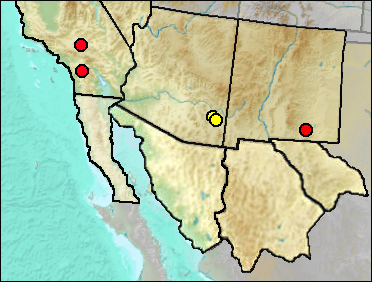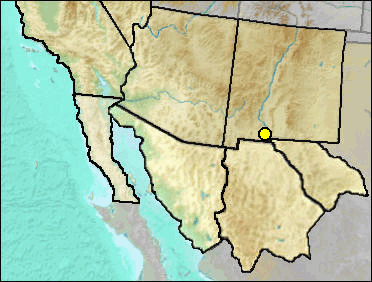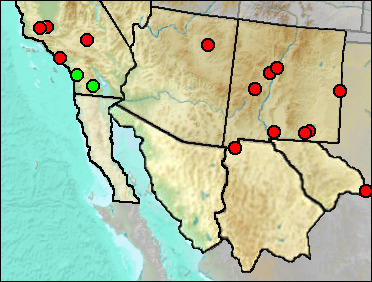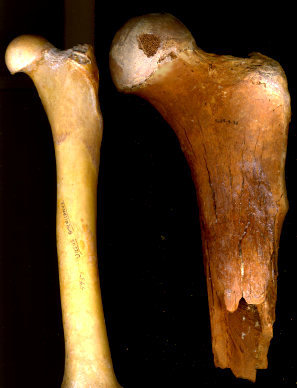Class Mammalia
Order Carnivora
Family Ursidae
Arctodus pristinus—Lesser Short-faced Bear // Arctodus simus—Giant Short-faced Bear

Morgan (2003) noted a large carnivore, possibly Arctodus simus, from the medial Irvingtonian site of Slaughter Canyon Cave; this is not mentioned by Morgan and Harris (2015) and is not otherwise noted here.
Sites.
Late Blancan: 111 Ranch (Morgan and White 2005); San Simon Fauna (Morgan and White 2005).
Irvingtonian/Rancholabrean: Manix Lake (Jefferson 1991b).
Mid/Late Wisconsin: Diamond Valley (Springer et al. 2009).
Late Wisconsin/Holocene: Burnet Cave (Schultz and Howard 1935: cf. gen.).
Literature. Jefferson 1991b; Morgan 2003; Morgan and Harris 2015; Morgan and White 2005; Schultz and Howard 1935; Springer et al. 2009: cf. gen.).

There is a single, tentative record of this bear from the region. Kurtén and Anderson (1980) considered this to be a primitive species of Arctodus, smaller and less specialized than A. simus.
Sites.
Late Blancan: La Union (Mesilla Basin Fauna B) (Morgan and Lucas 2005: cf.).
Literature. Kurtén and Anderson 1980; Morgan and Lucas 2005.

Synonyms. Arctotherium simum, Tremarctotherium simum.
 Arctodus
simus was noted by Kurtén (1967) as an exceptionally long-limbed bear, with the
difference being especially great for the hind limb, which is notably longer than the
forelimb. He suggested that the skeleton indicates adaptation to relatively fast
terrestrial movement but not adaptation for climbing or digging. He pointed out that
the skull was convergent upon those of the great cats, with a short, but very wide,
rostral breadth that suggested carnivory.
Arctodus
simus was noted by Kurtén (1967) as an exceptionally long-limbed bear, with the
difference being especially great for the hind limb, which is notably longer than the
forelimb. He suggested that the skeleton indicates adaptation to relatively fast
terrestrial movement but not adaptation for climbing or digging. He pointed out that
the skull was convergent upon those of the great cats, with a short, but very wide,
rostral breadth that suggested carnivory.
Kurtén concluded that it was "by far the most powerful predator in the Pleistocene fauna of North America" (p. 50).
Kurtén and Anderson (1980) gave terminal dates for occurrence south of the ice sheets as 12,650 ± 350 BP at Lubbock Lake, in the Texas Panhandle.
The record from the Isleta Caves was based on an identification by Kurtén, but the specimen cannot be found and apparently never returned. It also is not clear at this point whether the site involved was Isleta Cave No. 1 or No. 2; it has been listed in both, but apparently was identified only from one of the two sites.
Fig. 1. Proximal femur of Ursus americanus (left) and Arctodus simus (UTEP 5689.4.38). Some idea of size can be seen from the medial-lateral measurement of the head of the femur: 68.5 mm for Arctodus and 36.5 mm for Ursus americanus. Giant Short-faced Bear specimen from U-Bar Cave.
Kurtén and Anderson (1980) mapped two localities for Tremarctos floridanus (Florida Cave Bear) to New Mexico. The localities (apparently the Isleta Caves and Conkling Cavern) appear to actually pertain to Arctodus simus. Tremarctos is unrecorded from the state.
Arctodus hung on until the end of the Pleistocene; Fiedel (2009) gives terminal dates ranging from 11,610 ± 90 to 10,870 ± 75 BP.
Sites.
Irvingtonian: Anza-Borrego (Shaw and Cox 2006); Elsinore: Microtus/Mammuthus (Pajak et al. 1996).
Rancholabrean: Bitter Springs Playa (Jefferson 2014); Keams Canyon (Richards et al. 1996); Lake San Agustín (Morgan and Lucas 2005); Oso Cave (Richards et al. 1996).
Early Rancholabrean: Albuquerque Gravel Pits (Morgan and Lucas 2005).
Late Rancholabrean: Big Bear (Morgan and Lucas 2005).
Mid Wisconsin: McKittrick (Schultz 1937); U-Bar Cave (Harris 1987).
Mid/Late Wisconsin: Rancho La Brea (Stock and Harris 1992).
Late Wisconsin: Burnet Cave (Schultz and Howard 1935); Conkling Cavern (Conkling 1932: sp.); Cueva Quebrada (Lundelius 1984); Isleta Cave No. 1 or Isleta Cave No. 2 (Harris 1993c); Maricopa (Jefferson 1991b).
Literature.
Conkling 1932; Fiedel 2009; Harris 1987, 1993c; Harris and Findley 1964; Jefferson 1991b, 2014; Kurtén 1967; Kurtén and Anderson 1980; Lundelius 1984; Morgan and Lucas 2005; Pajak et al. 1996; Richards et al. 1996; Schultz 1937; Schultz and Howard 1935; Shaw and Cox 2006; Stock and Harris 1992).
Last Update: 4 Feb 2016